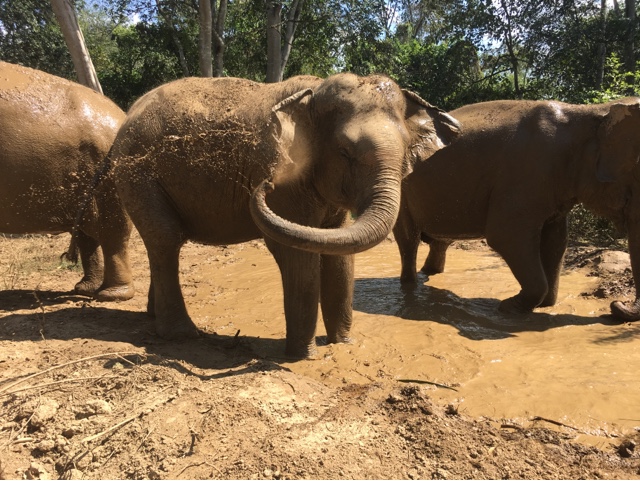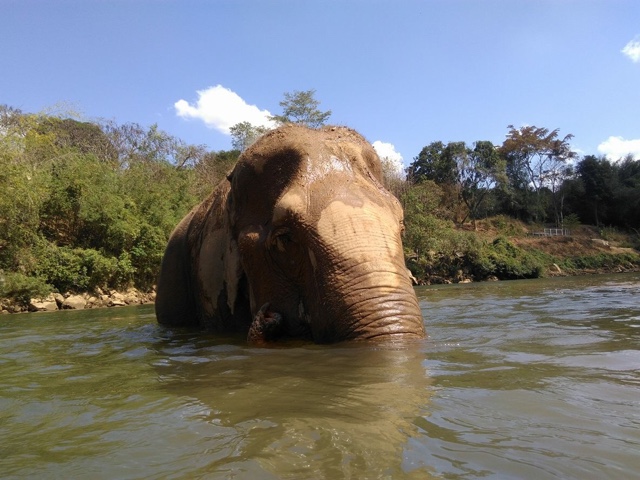About 5 years ago I had my first experience with seeing elephants up close. While on safari in Tanzania with Javi and Roz, we debated whether or not elephants could run.
I was convinced that being as large as they were, they would be content to amble aimlessly through the forest, eating bits of pineapple leaves and palm fronds. Or rather non stop eating since elephants have to eat 18 hours a day to maintain their mass.
Of course I was soon proven wrong as we watched an elephant charge across the dusty parking lot at a tourist offending said elephant in his red shirt, barely escaping being trampled when he shrunk down into a fetus position and was saved by the sudden calm that overtook the 12,000 lb animal.
(Read more about that adventure here: http://jenstraveltales.blogspot.com/2011/07/do-elephants-run.html?m=1)
Then again, these were African elephants that lived in the protected Serengeti. . Asian elephants are smaller – almost half African elephants’ size, but equally as hungry also requiring almost non stop eating when not asleep.
What I didn’t learn until I spent a day with 5 female rescued Asian Elephants at the Elephant Haven in Western Thailand was that Elephants were initially used by the South East Asian people as Westerners used mules and horses – for transportation and logging.
Later as logging became illegal in many counties, former work elephants were taught to juggle and paint and to balance balls on their trunks to woo the Western tourists. Heavy saddles were stills trapped on their backs and they were worked sometimes 10 hours a day giving rides and shows to the Westerners that visited.
There was simply just not enough time for them to eat and if one watched, and knew elephants well, they would be able to tell that their joy for life had been stripped away.
Transporting tourists, like logs, all day gave them little time for the quantity of eating they need to do to maintain their weight for their 60-80 years of life. It gave them little time to play in the water as they love to do, flopping their tremendous bodies on their sides and splashing themselves with their trunks. It gave them little time to throw dirt or mud on their backs to cool off and protect themselves from the sun. To live their mantra of eat, play, sleep, repeat.
Between their lives as circus animals and tourist toys, they were also hunted for their tusks, tails and eyelashes, leaving them in danger of extinction and living a sad, sad existence in the few moments they were still found in the wild.
Asian elephants are giant herbivores with muscular trunks that can tear down trees, and standing next to them as they used these trunks to scoop rice balls, cooked pumpkin and cut watermelon out of my hand into their cavernous mouths was like nothing I had experienced in my life. They were seemingly scary and at the same time gentle.
Kup, my guide explained to stay always to one side of them as their tails, trunks and ears were in constant motion to flick off insects and keep them cool. He said that getting between two elephants was like “making yourself into orange juice” and I imagined myself being crushed between two 6000 lb animals.
Today, there are fewer than 40,000 elephants left in Asia and while some of the tourist agencies that once dedicated themselves to using elephants to amuse tourists are now attempting to become their “retirement” sanctuaries, many continue to offer folks the chance to mount and ride them, hand them paint brushes to woo foreign visitors (really – what would make someone want to see an elephant paint? How is that natural??) and leave them chained up with very little room to roam, eat or play when not “working.”
As travelers, it is our responsibility to travel ethically. To attempt to take only photographs and leave only footprints. To do our best to avoid disrupting the people, environments and animals that came before we came with our curiosity, our disposable incomes and lack of consideration for preservation. We owe it to the elephants.
We owe it to the people who have lived for centuries before Western travelers decided that X, Y or Z was the next undiscovered destination on the tourist path.
We owe it to future generations.








No comments:
Post a Comment